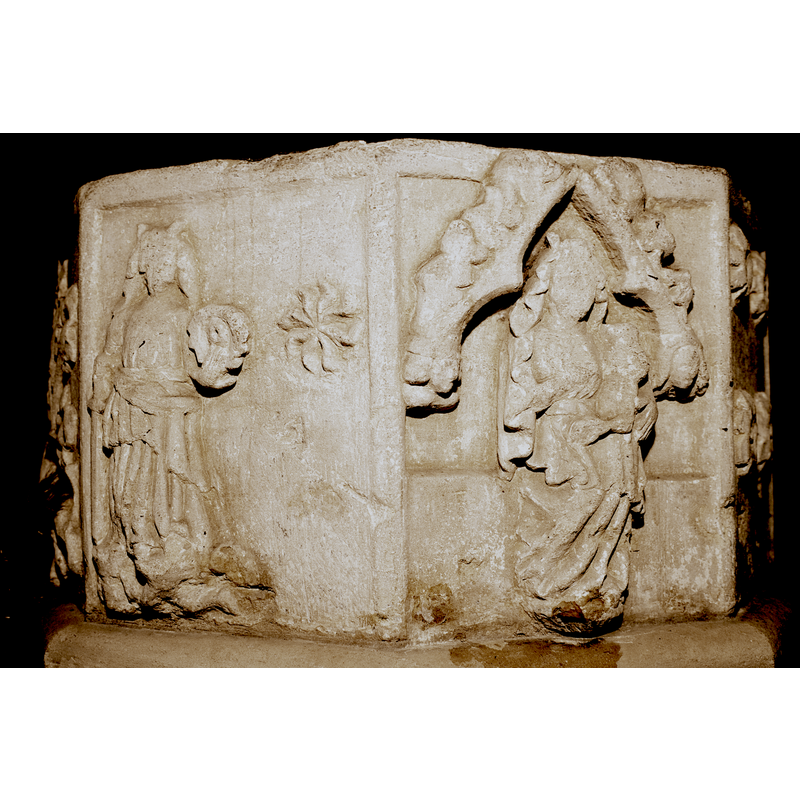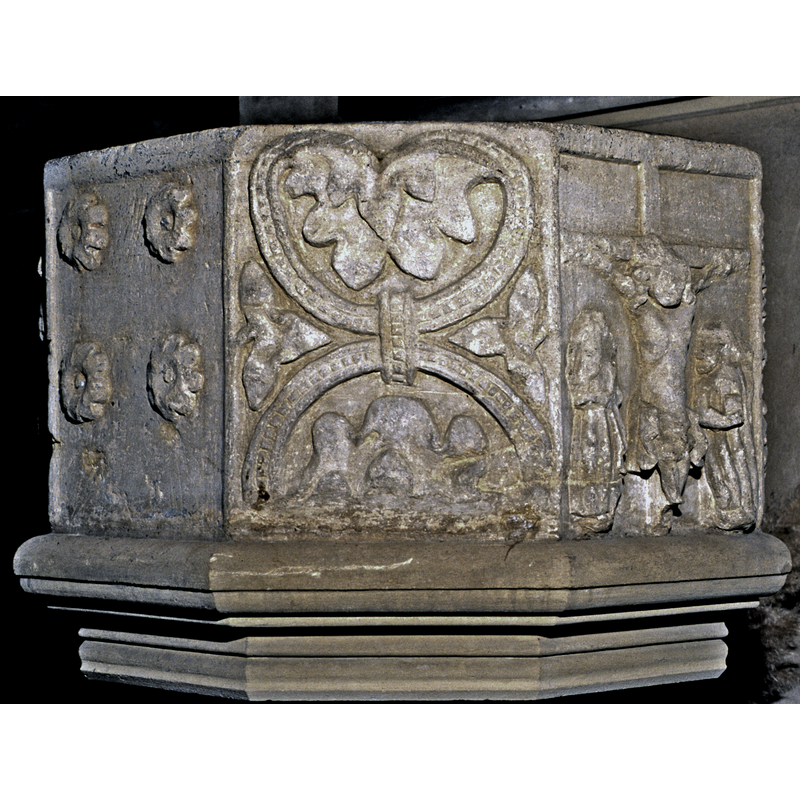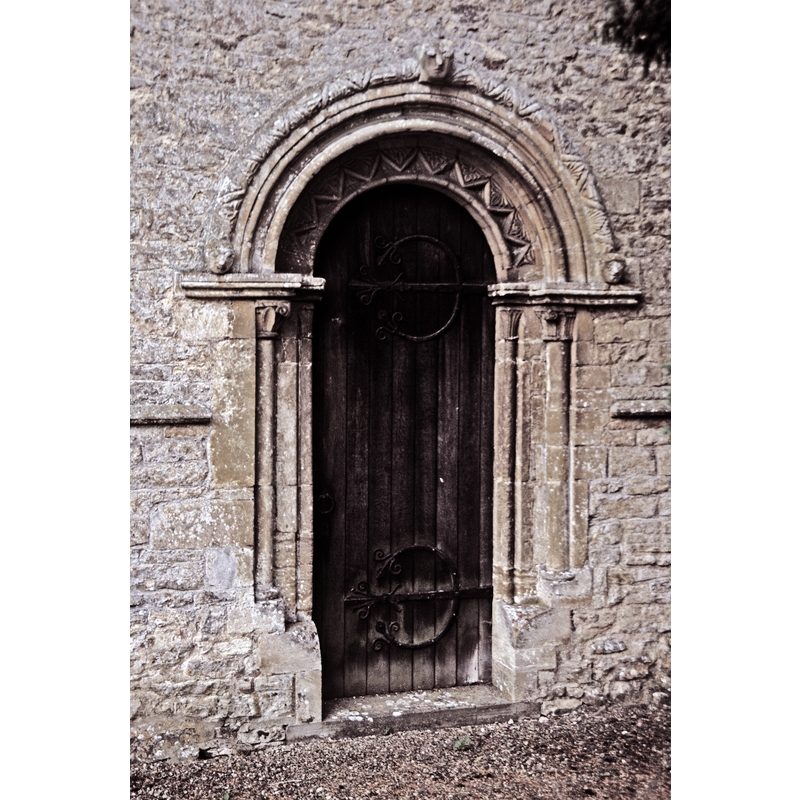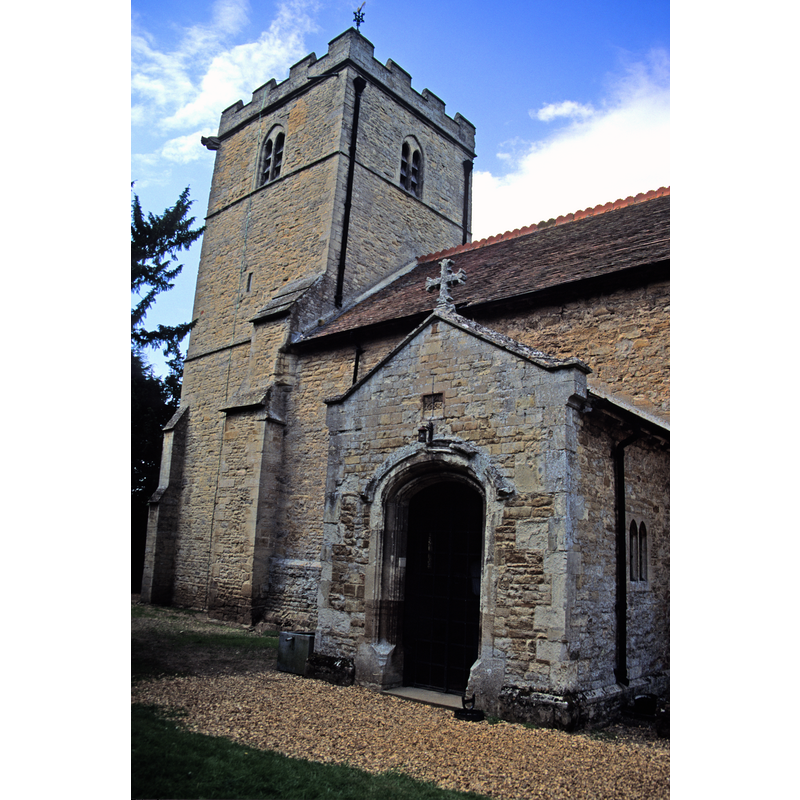Leckhampstead nr. Buckingham / Lechamestede / Lechamstede / Leckhamstead / Lekhampstead
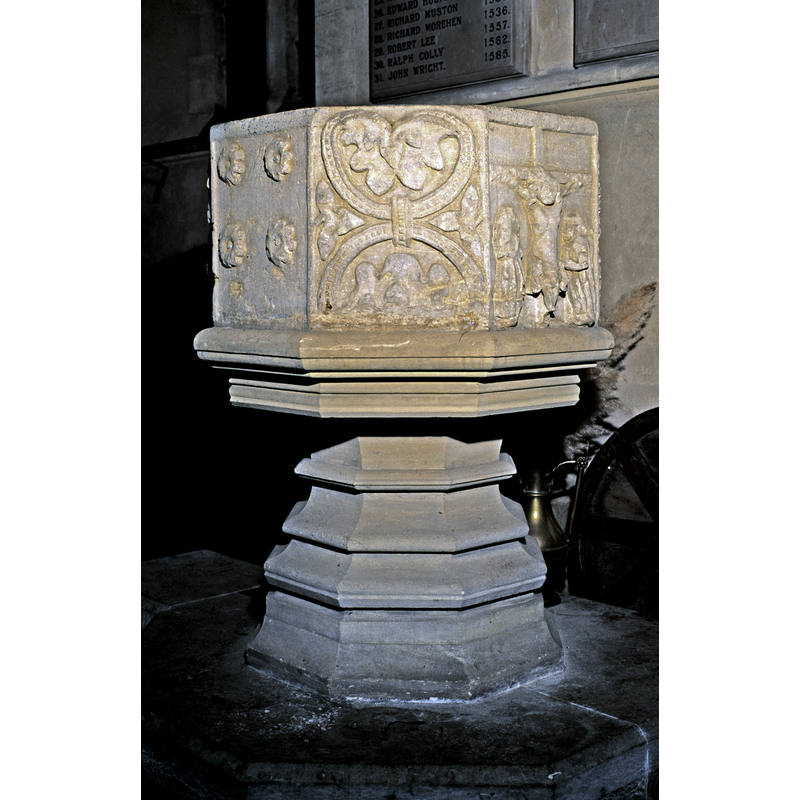
Image copyright © Baptisteria Sacra Index, 2023
Results: 15 records
B01: New Testament - Passion of Christ - Crucifixion
Scene Description: damaged and intriguing
Copyright Statement: Image copyright © Corpus of Romanesque Sculpture in Britain and Ireland, 2016
Image Source: photograph by Ron Baxter in the CRSBI [www.crsbi.ac.uk/site/3161/] [accessed 17 January 2016]
Copyright Instructions: PERMISSION NOT AVAILABLE -- IMAGE NOT FOR PUBLIC USE
B02: design element - motifs - leaf - oak - beaded-tape motif
B04: animal - fabulous animal or monster - dragon - eating plant
B05: Apostle or saint - St. Catherine of Alexandria
B06: Virgin Mary - Madonna and Christ-child
B07: design element - motifs - floral - rosette - (4)
B08: design element - motifs - interlace - beaded-tape - foliage
view of church exterior - detail
view of church exterior - north portal
view of church exterior - south portal - tympanum
view of church exterior - southeast view
view of font
view of font
INFORMATION
FontID: 01339LEC
Object Type: Baptismal Font1
Church/Chapel: Parish Church of the Assumption of the Blessed Virgin Mary
Church Patron Saints: The Assumption of St. Mary
Church Location: Church End, Leckhampstead, Buckinghamshire MK18 5NU
Country Name: England
Location: Buckinghamshire, South East
Directions to Site: Located 6 km NNE of Buckingham, about 10 km W of Milton Keynes
Ecclesiastic Region: Diocese of Oxford
Historical Region: Hundred of Stotfold [in Domesday] -- Hundred of Buckingham
Font Location in Church: Inside the church, at the W end of the N aisle
Century and Period: 14th - 15th century [basin only] [re-cut in the 14th century] [composite font], Medieval [composite]
Cognate Fonts: [cf. FontNotes]
Font Notes:
Click to view
There are three entries for this Leckhampstead [variant spelling] in the Domesday survey [http://opendomesday.org/place/SP7237/leckhampstead/] [accessed 15 January 2016], neither of which mention cleric or church in it. The Lysons (1806-1833) note an octagonal baptismal font decorated "with bas-reliefs of the Crucifixion, St. Catherine, &c. rudely executed". Illustrated in The Gentleman's Magazine (vol. 85, pt. 2, 1816: 497). Simpson (1828) writes: "Knowing how frequently those who are very positive in their interpretation of our ancient sculpture fall into great error, we offer our explanation of the animal on this Font, with a branch in its mouth, with diffidence. We can only suppose, as in the Helpringham Font, that it may relate to a part of the eightieth Psalm. To the next two figures we can give names with greater confidence; the one is St. Catherine with her wheel, the other, the Virgin and Child [...] One of the other sides has the nail head ornament. The heads of the figures, which are in very high relief, are defaced; but the Font otherwise is in good condition, save that the usual display of a churchwardens' taste has been made upon it, by painting the bowl bright blue." Simpson locates the font ca. 1828 in the same place as it is at present [July 1998], although the base on which the font appears in Smpson's drawing is no longer there [cf. on-site notes below]. Reported in Lewis' Dictionary of 1848 much in therms used by Lysons [cf. supra]. Sheahan (1862) reports that this church contains "some rich remains of the Norman period [...] The large octagonal Norman font has in panels in bas-reliefs, the Virgin and Child, the Crucifixion, St. Catherine and her wheel, a mitred figure with a crozier in his hand, a monogram, &c." and notes that the Gentleman's Magzine and Simpson [cf. supra] had both illustrated the font already. Cox-Harvey (1907) and Bond (1908) describe it as a late-14th-century tub font with curious carvings on the eight panels, two of them representing the Blessed Virgin and St. Catherine. [NB: C&H {ibid.) list it as Perpendicular, of the 14th century]. The Victoria County History (Buckingham, vol. 4, 1927) notes: "The font has an early 14th-century octagonal bowl, four sides of which have sculptured representations of the Crucifixion, the Virgin and Child below a crocketed canopy, St. Catherine, and a bishop; the other four sides are embellished with conventional foliage, the leaves on the south-east side being connected by a strap-like ornament which might be confounded with earlier work but for the typical 14th-century foliage with which it occurs and in the design of which it obviously forms a part. The stem and base are modern." Tyrrell-Green (1928) mentions scroll-work on this font "exceptionally [...] in both positions -at the top and the base [NB: it is not clear whether or not a different base -ornamented with scroll work- existed at the time of Tyrrel-Green's observations, ca. 1928]. Pevsner (1960) notes: "Font. Originally circular, made octagonal in the C14, with one Normal panel of symmetrically arranged foliage, and seven of the C14, including the Crucifixion, the Virgin seated, the Virgin of the Annunciation, and a Bishop." On-site notes: on the eastern side of the basin there is a Crucifixion scene; moving to the right, there is a panel with a branch from an oak tree; then there is the figure of a Bishop, followed by a scene of a serpent-like creature eating a plant; a representation of St. Katherine followed by the Madonna and Child and then, on the seventh planel, four rosettes; the eighth panel shows two joined semi-circles with a plant motif inside. The font is octagonal with a modern base and plinth. [NB: the font no longer stands on the quadrangular base shown in Simpson's drawing of 1828; it no longer has the iron staple on the upper rim as shown in his illustration and, o mercy of mercies, the bright-blue coat of paint is gone as well! There is no knowledge of Tyrrel-Green's scroll-work ornamented base]. A recent [11 November 2006] photograph of this font by "cbnewham" appears in FLICKR [http://www.flickr.com/photos/digiatlas/294787006/] [accessed 19 August 2007] with the following caption by the photographer: "An octagonal font showing on its faces some strapwork, flowers, Virgin and Child, St Catherine, a dragon creature, a bishop, a green man, and the Crucifixion. There is debate about the font as the strapwork decoration is of 12th Century type whereas the rest is 14th Century. The RCHM suggests the font is a 12th Century circular one cut down to an octagon. Obviously they were smoking something; the "12th Century" panel is flat for a start, not curved as it would have to be if from a circular font. Pevsner suggests it is all 14th Century. I agree. It was never cut down and the problem panel bears a striking similarity to the font at nearby Maids' Moreton. However, it is not by the same hand and is, to my eye, a poor attempt at copying some of the design on that font. Also, the dragon creature has a similarity to the two dragons on the south doorway tympanum. My conclusion: entirely 14th Century with some imitation 12th Century thrown in for good measure. The base, by the way, is modern". The CRSBI (2016) writes: "The octagonal font is an enigmatic piece; 15thc in its present form but with one panel carved in a Romanesque style. [...] In the N aisle, alongside the N doorway; an octagonal monolithic bowl on a 19thc moulded stem with a modern octagonal step. The inner basin is lead lined, and the lead also covers the rim. The 8 panels on the bowl are carved in relief with figural scenes and foliage motifs, one of which, at the NE, has been called 12thc. It is a symmetrical composition divided into two main fields by straplike nailhead stems clasped at the centre, the upper field cordate and the lower semicircular. At the top the ends of the stem join with a trilobed leaf terminal within the heart-shaped field, and outside this leaf but still within the heart is another leaf with six lobes. The lower field is decorated with a pair of superimposed trilobed leaves, and in the spandrels to L and R are further triangular trilobed leaves. [...]
The font is described in Pevsner (1960) as, “originally circular, made octagonal in the C14, with one Norman panel… and seven of the C14.” This analysis was from the RCHM(E) description, and in the revised edition (1994) Williamson pointed out serious problems with it. The “Norman” panel shows no sign of ever having been part of a circular bowl. Whatever its date its framing and geometry demonstrate that it was always a panel of a regular octagonal bowl. The design of the panel and its clasped stems with nailhead ornament are certainly Romanesque forms, but the leaves are not. Their rippling surfaces, especially apparent in the flanking triangular leaves, relate them to the kind of foliage seen on the bosses of the screen at Beverley Minster of c.1335 and remained part of the sculptor’s stock-in-trade throughout that century. They are similar to 14thc leaves elsewhere on this font, and in the revised edition of Pevsner the entire bowl is dated to the early 14thc. This raises the possibility that this panel is a 14thc pastiche of 12thc work, perhaps carved as a reminder of an old font that was replaced. Something similar happened in the nave arcade, dateable with the N doorway, where new label stops were added to piers 1 and 2 in the 14thc, and a 12thc corbel was pressed into use as a label stop for pier 3. Likewise the arcade apex heads show a mixture of 12thc (bays 1 and 2) and 13thc-14thc (bays 3 and 4) styles, but in this case there is no question of pastiche."
COORDINATES
Church Latitude & Longitude Decimal: 52.0348, -0.9431
Church Latitude & Longitude DMS: 52° 2′ 5.28″ N, 0° 56′ 35.16″ W
UTM: 30U 641090 5766906
MEDIUM AND MEASUREMENTS
Material: stone, type unknown
Font Shape: octagonal (mounted)
Basin Interior Shape: round
Basin Exterior Shape: octagonal
Rim Thickness: 9-12 cm
Diameter (inside rim): 59 cm / 57.5 cm* /
Diameter (includes rim): 78-84 cm / 77.5 cm* / 80-84 cm**
Basin Depth: 30 cm / 32.5 cm*
Height of Basin Side: 41 cm
Height of Base: 72 cm [modern base]
Basin Upper Panel Dimensions: 32 x 40 cm/ 33 x 41 cm** [SE panel]
Font Height (less Plinth): 114 cm / 110 cm*
Font Height (with Plinth): 137 cm
Notes on Measurements: BSI-on-site / * Simpson (1828) / ** CRSBI (2016)
LID INFORMATION
Material: wood, oak?
Apparatus: no
Notes: round and flat, with radii atop and knob handle; date unknown
REFERENCES
Victoria County History [online], University of London, 1993-. Accessed: 2011-05-31 00:00:00. URL: https://www.british-history.ac.uk.
Bond, Francis, Fonts and Font Covers, London: Waterstone, 1985 c1908
Corpus of Romanesque Sculpture in Britain and Ireland, The Corpus of Romanesque Sculpture in Britain and Ireland, The Corpus of Romanesque Sculpture in Britain and Ireland. Accessed: 2016-01-17 00:00:00. URL: http://www.crsbi.ac.uk.
Cox, John Charles, English Church Furniture, New York: E.P. Dutton & Co., 1907
Lewis, Samuel, A Topographical Dictionary of England, Comprising the Several Counties, Cities, Boroughs, Corporate and Market Towns, Parishes, Chapelries, and Townships, and the Islands of Guernsy, Jersey, and Man, with Historical and Statistical Descriptions [...], London: S. Lewis, 1831
Lysons, Daniel, Magna Britannia, being a concise topographical account of the several counties of Great Britain, London: Printed for T. Cadell and W. Davies, 1806-1822
Pevsner, Nikolaus, Buckinghamshire, Harmondsworth: Penguin, 1960
Sheahan, James Joseph, History and topography of Buckinghamshire, comprising a general survey of the county, preceded by an epitome of the early history of Great Britain, London; Pontefract: Longman, Green, Longman, and Roberts; William Edward Bonas [...], 1862
Simpson, Francis, A series of ancient baptismal fonts: chronologically arranged, drwan by F. Simpson, Jun., engraved by R. Roberts, London: Septimus Prowett, 1828
Tyrrell-Green, E., Baptismal Fonts Classified and Illustrated, London: Society for Promoting Christian Knowledge: The Macmillan Co., 1928




